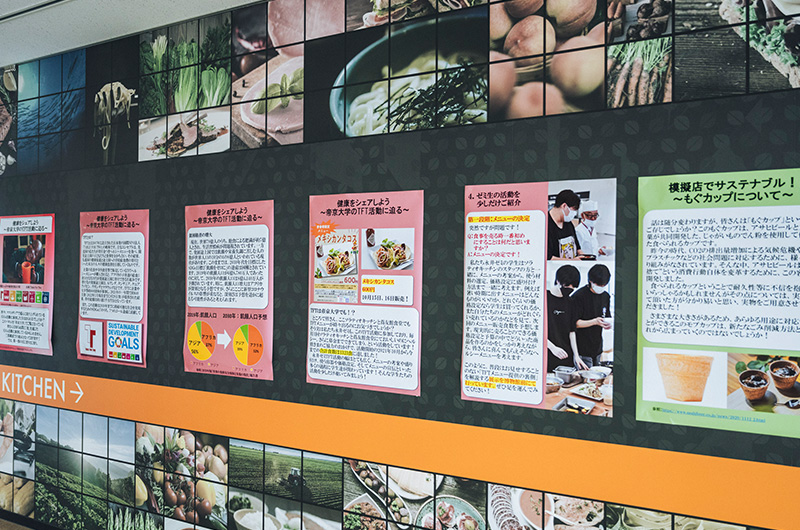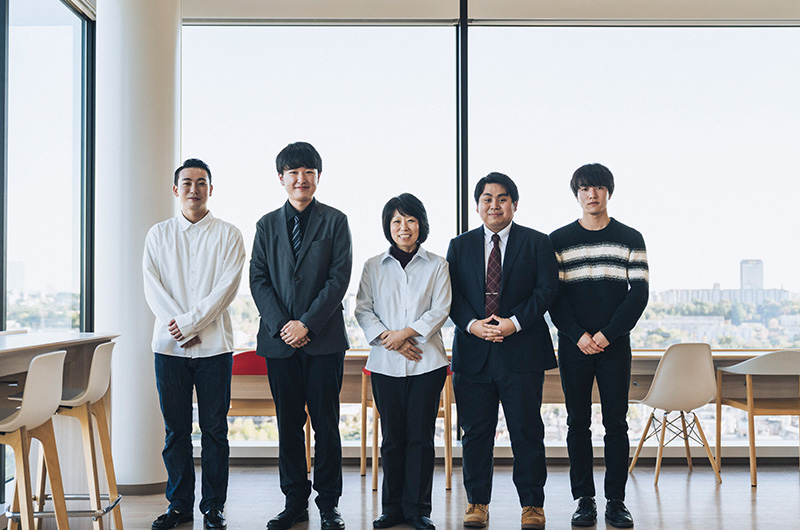
活動レポート


- 構造を把握する「歴史」という道標 -
![]()
![]()
![]()
![]()
![]()
![]()
![]()
![]()
![]()
![]()
![]()
![]()

帝京大学経済学部 講師 永井 リサ
専門は、環境史、生態史、中国東北史で、大学院時代に中国に留学。特に、中国東北地方の森林ビジネスの歴史に精通している。単なる歴史ではなく、現代の経済や資源の状態から歴史的な背景を遡って調査・研究している。2009年から大阪大学大学院経済学研究科にて特任研究員、2014年に中国・大連大学講師を経て、2015年に、専門研究員として、九州大学総合研究博物館で研究に従事。2020年より帝京大学経済学部 講師となり、環境経済学で教鞭をとる。

今回私たちのゼミは、帝京大学八王子キャンパス内の学食の協力を得てTFT活動を実施しました。TFTとは国内のNPO法人が展開している活動で、TABLE FOR TWOの略。特定のメニューが1食提供されると、アジア・アフリカの国に学校給食1食分=20円が寄付される仕組み。寄付先は東アジア5カ国とフィリピンですが、今年度研究対象として選んだのはケニアです。方法はまず、学食の運営会社と一緒にTFT用メニューを開発していきました。さらに、キャンパス内にある博物館、エントランス、学食前スペースの3カ所を活用し、ケニアの文化、経済状況、先進国とのGDP比較などをまとめたパネル展示を準備しました。多くの学生に対しTFT活動を訴求するため、場所ごとに展示内容を変えるといったアイデアも生まれました。今回のプロジェクトはすべてゼミ生が企画・運営しています。基本的に私の協力はごくわずかのみ。結果は良好で、学生にも認知が広まりある程度まとまった寄付を提供することができました。SDGsに対する知見も深まり、ゼミの活動としてユニークなノウハウが蓄積されています。
なぜ学生中心で活動しているのか。もちろん真意があります。そもそも、なぜケニアが寄付を受け取らなければ学校給食の提供もままならない国になっているのか。歴史的背景や、現状把握、そして実際に国内では状況改善のためにどのような取り組みが行われているのかといったことを調査し、理解し、その上でTFTが持つ価値や意味を正確に把握してもらいたいと考えたのです。確かに、先進国での寄付行為は途上国の負荷軽減に効果があります。しかし支援が不要になる程に途上国が自立し、持続可能な発展を続けられることの方が重要ですしSDGs的な意義とも合致します。仮に寄付の必要性が高まり続けるような状態であれば、問題は解決せず深刻化しているとも言えます。これでは、寄付は単なる施しにしかなりません。先進国に生きる私たちの生活は、マクロな経済で見れば途上国の労働力の上に成り立っています。だからこそ私たちは本質的な問題を理解し、根本的な課題解決のために行動していく責任があります。学生たちには今回のプロジェクトに取り組むことで、そうしたことに対する新たな気づきを得てもらえればと考えました。

私の専門は環境史や生態史です。特に中国を研究してきました。大学時代、中国の山西省に短期留学したことがあります。夏に雑草の影もないくらい、驚くほどの砂漠です。しかし歴史的には豊かな森林地帯だったと言われています。ここで疑問が湧きました。なぜ歴史的に木を植えてこなかったのか、なぜこうなるまで何もできなかったのか。古い記述を辿れば考古学の領域の研究になります。殷や周といった太古の中国の宮殿には巨木が使われているので、豊かな森林資源が活用されていたことがわかっています。研究を進めていくと、近現代における森林資源減少が特に顕著であったこともわかりました。たとえば、1900年代初頭に設立された南満洲鉄道株式会社は、線路の敷設やさまざまな経済活動の結果として膨大な木材を用いてきました。また、日露戦争時には、中国、ロシア、日本が同じように木材を使用し続けていました。こうした記録は木材行政として残っているので、文献を紐解いていけば詳細な状況がわかります。
環境資源と経済の関係は切っても切れないものです。森林資源がどのような変遷をたどったのか調査することで、経済状況や社会状況など多くのヒントを得ることができます。こうして、私の研究は近代や現代へと裾野が広がり、現在は大体この100年ほどの経済史を専門的に扱うに至っています。100年前と現在ではさらに状況が異なります。たとえば、現在の中国東北にある木材市場はロシアの木材で埋まっています。産地をたどればロシアに入り、シベリアにも行くことになります。鉄道敷設等の物流の進化がシベリアのタイガを世界経済に直結させ、木材消費に拍車をかけます。車や道路が走ることで、その地域は世界経済につながり、あらゆるモノが資源として消費対象となっていきます。そこには国や人種を超えた往来もあり、多種多様な歴史が刻まれるのです。
現在私が教えている環境経済学は、環境問題を経済学から分析する学問です。必要な政策のあり方について考えたり、税金をいかに効率よく使っていくのかというテーマも内包しています。SDGs的観点が求められる現代において注目されている分野と言えます。もちろん、環境のことを考えたらお金のことを言っている場合じゃないといった批判があって然るべきです。しかし、たとえば温暖化対策だけに税金を無尽蔵に投入すれば、社会に無数に発生する数多くの問題が解決できなくなってしまいます。バランスを重視しながら深刻化する未来の課題と向き合うために、環境経済学の存在の重要性が増しているとも言えます。
世界に目を向ければ、途上国における人々の自立を促すための経済的な方法論の確立が急務です。海外からの援助がなくても、現金収入がほとんどなくても、豊かになっていけるのか、そういう手段はあるのかという研究も我々の領域だと言えます。中国の農村を研究していると、山東省などでは、かつてはどんな社会環境変化にも耐えられるようにと、生産効率が悪くてもたくさんの種類の作物を育てていたのが、世界市場につながり経済的効率のみを重視することになると、商品作物中心で生産せざるを得ない仕組みに置き換わっていくのがわかります。大資本により借金を増やされ、返済のため利益が出る高い作物を作らざるを得なくなる。もちろん、それが豊かさに繋がることも多々あります。しかし災害や紛争など、市場の変化で売上が左右されたり、作物が枯れたりすれば、あっという間に村が飢饉になり存亡の危機に立たされることも珍しくはありません。近現代のグローバル経済には、強烈なメリットとデメリットが共存しており、元に戻すことは難しい。新しい未来を作るためには、再び新しい方法論が必要になる。こうした歴史的な繰り返しの中で、いかに強靭で自立した未来を作れるのか。それが私たちに突きつけられている課題なのです。
SDGsの裾野は歴史的背景まで考慮するならば、とてつもなく深く複雑です。表面的には、経済格差のように見える先進国と途上国の課題も、植民地時代のことや戦争の歴史にまでさかのぼるケースも多々あります。ある意味において、真剣に取り組もうとすればするほど身動きが取れなくなるような状況でもあります。しかし、気候変動も紛争問題もエネルギーの課題もすべてが待ったなしの状況です。私たちは前進し、社会を変革していかなければなりません。その点において、今回取り組んだTFTのような活動はシンプルにSDGsに関与するための扉を開いてくれます。

ひょっとしたら、今回プロジェクトを遂行した学生の中から、国際的に行動する企業に就職したり、新しいエネルギーを作り出す企業にかかわったり、社会を変革するような起業家が生まれる可能性だって否定できません。未来はまだ何も決まっていません。歴史は、私たちの想像を遥かに超える困難と突破の連続でできています。蓄積された叡智は膨大であり、豊かになる手段へのヒントがまだまだ隠されていることでしょう。今回の取り組みを通して、かかわった学生が新しい世界を作っていくためのモチベーションを手にしたのであれば、それこそが私たちのできるSDGs実現への貢献の第一歩です。学生たちにはどんどん世界を見て、歴史や構造を知り、新しい未来を切り拓く存在になってもらえればと期待しています。